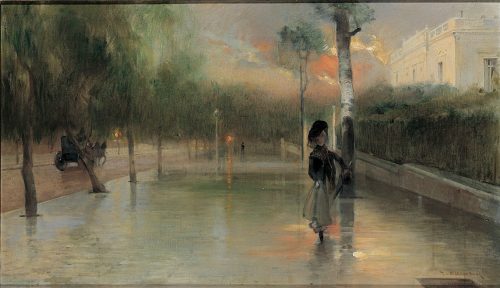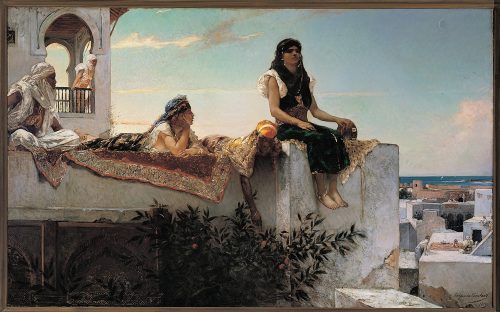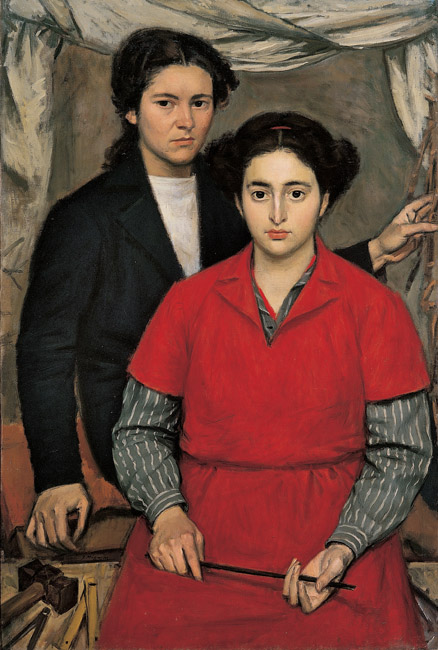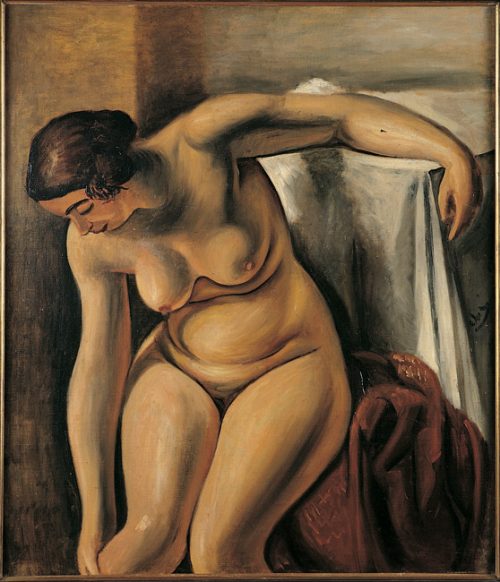
TEMPORARY EXHIBITION IN INTERACTIVE TOUR
From 20.12.2006 to 31.03.2007
The history of modern Greek art is generally seen as revolving around the bipolar relationship Athens-Munich and Athens-Paris. The so-called “Munich School”, which prevailed in the Greek art scene in the latter half of the 19th century, has been extensively studied and illuminated, and the misconceptions surrounding it have been resolved. The exhibition “Paris – Athens” aims to illuminate the relationship of the Greek painters with their direct and indirect French teachers. This was a multifaceted, productive and often surprising dialogue. Greek painters found themselves in Paris as early as the 19th century. The starting point for the exhibition “Paris – Athens” is the year 1863, when the Salon of the Rejected (Salon des Refusés) was organized, in which a Greek, Nikolaos Xydias, appeared alongside Manet and Cézanne. The Orientalist painter Theodoros Rallis, Gérôme’s student, and Iakovos Rizos, a student of Cabanel whose painting captured the essence of the Belle Époque, were also enjoying successful careers in Paris at the time. All three of these painters were familiar with the new movements but adhered to academic painting. There was an exception: Pantazis, who after a short stay in France moved to Brussels, where he became a leading modernist artist.
The modernist trends from Paris reached Greece, changing the course of Greek art in the early 20th century. It was a favourable time, when Eleftherios Venizelos rose to political prominence. He was an advocate of the new artistic movements. Almost every Greek painter now sought to be educated in Paris: Galanis and Maleas had already been there since the early century; Parthenis followed, along with Papaloukas, Kontoglou, Ghika, Engonopoulos, Gounaropoulos, Economou, Triantafyllidis, Tsarouchis, Diamantopoulos and Moralis. The Greek painters who made the now customary pilgrimage to Paris were influenced by various movements. Yet, they never slavishly imitated their teachers. With the outbreak of World War II, the Paris-based Greeks returned home. Thus, the other boudary for the exhibition is 1940. What is it that the Greek painters owe to their French teachers? Who were the most influential teachers of the Greek artists? The exhibition “Paris – Athens” aspires to provide answers to these questions through specific examples.
The Greek artists adopted the teachings of Cézanne and a milder Fauvism. The influence of the Symbolists, the Nabis – above all Maurice Denis, who inspired Parthenis, especially in his decorative works – was also substantial. The decorative curve of the Art-Nouveau style can be traced in many Greek painters: Maleas, Parthenis, Papaloukas. In the period between the two Wars, the “return to order” as well as to tradition, now prevailing in Europe, encouraged the search for “Greekness”, which culminated in the painters of the Generation of the Thirties. Modernism and tradition converge in distinct blends in the oeuvres of Tsarouchis and Diamantopoulos (folk art and Matisse), Engonopoulos (Byzantine, folk art and De Chirico), whereas Derain and Galanis influenced Vassiliou, Frantziskakis and Moralis. A case apart is Hatzikyriakos-Ghika, who entertained an ongoing conversation with post-Cubist Picasso, enriching the latter’s teaching with Greek light and colour.
A special place in the exhibition is reserved for the legendary publications of the Greeks Christian Zervos and Tériade, who both played an important role in Parisian art life during the period between the two Wars, and the engravers Galanis, Kefallinos, Theodoropoulos, who studied and worked in Paris. In the exhibition “Paris – Athens”, 60 works by French artists are on display, coming from France, Switzerland, the US, Canada and Greek private collections. Among them are works by Gérôme, Cabanel, Boldini, Puvis de Chavannes, Maurice Denis, Valloton, Bonnard, Renoir, Cézanne, Manguin, Derain, Matisse, De Chirico, Picasso and Fautrier. Moreover, 160 paintings by Greek artists and 170 engravings by artists from both countries are on show.
This is one of the most important exhibitions ever organized by the National Gallery on the basis of the history of art and as well as on a purely artistic and aesthetic basis, as works of extraordinary quality by Greek and French artists are on display. The exhibition is a collective effort under the general supervision and coordination of the Director Marina Lambraki-Plaka, who also conceived the idea of this exhibition. The following curators worked for the exhibition: Olga Mentzafou, who also edited the monumental 450-page catalogue, Efi Agathonikou, Maria Katsanaki, Marilena Kassimati, Nafsika Litsardopoulou, Lina Tsikouta.
The exhibition is organized under the auspices of the French and Greek Ministries of Culture.
The exhibition was sponsored by EUROBANK-Private Banking as the culmination of a three-year long sponsorship agenda, also including the exhibitions “Georgios Iakovidis” and “Alekos Fassianos”.
Exhibition’s sections
The exhibition “Paris – Athens” aspires to illuminate the multifaceted relationship between the Greek painters and their direct and indirect French teachers. The Salon of the Rejected (Salon des Refusés) is taken as the starting point for the exhibition. In this Salon, the Greek painter Nikolaos Xydias showed his work, along with Manet, Cézanne and other Impressionists. The other boundary for the exhibition is the war outbreak in 1940, when Greek painters were forced to return from Paris to Greece. The exhibition is arranged in a number of sections. The following are the key groupings:
Academic Greek painters in Paris: Xydias, Rallis, Rizos, Mathiopoulos, and their French teachers. Urban space and the Belle Époque. The case of Pantazis and his relationship with Courbet’s realism, the Barbizon School landscape painters and the precursor of Impressionism Boudin. Cézanne’s teaching and his influence on Greek artists: Parthenis, Maleas, Miliadis, etc. Symbolism, the Nabis and the decorative style of Art Nouveau: Puvis de Chavannes, Maurice Denis, Sérusier and Parthenis. Decorative stylization in landscape painting. Intimisme and the Nabis, and artists such as Sofia Laskaridou, Economou, Vyzantios, Triantafyllidis. A new interpretation of space. The influence of Derain and Galanis on Greek painters: Kontoglou, Moralis etc. The influence of the two painters on landscape and still life painting. Modernism and tradition. Matisse’s influence on the painters of the Generation of the Thirties: Tsarouchis, Diamantopoulos, Asteriadis etc. Cubism, Picasso and Hatzikyriakos-Ghika.
Expressionism in Greece: Rouault and Bouzianis.
De Chirico, Metaphysical painting, Surrealism and its influence on Greek painters: Steris, Ghika, Engonopoulos.
Toward Abstract Art.
Greek engravers who studied or worked in Paris, and their French teachers: Galanis, Kefallinos, Theodoropoulos etc.
The Greeks Christian Zervos and Tériade (Efstratios Eleftheriadis), their seminal publications and their great impact on the Paris avant-garde.
Marina Lambraki-Plaka
Professor of History of Art
Director, National Gallery- Alexandros Soutsos Museum

1

2

3

4

